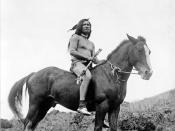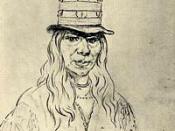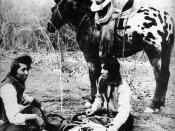The Nez Perce, a group of Native Americans located in what is now Idaho, were first contacted by Lewis and Clark in 1805 and were later given the name "Nez Perce" by French Canadian fur trappers who entered the area in the 1812. According to Haines 1955, there are two explanations for this name. The first is that the trappers saw a few Nez Perce women in the villages with shell nose ornaments. The second explanation is based on the sign language of the Plains Indians. One of their signs for the Nez Perce was made by passing the extended index finger of the right hand from right to left close to the nose. The French Canadians assumed this sign meant a pierced nose, when in reality the sign signifies a person who would not flinch from an arrow shot right by his nose, a brave man.
At the time of the Lewis and Clark contact, the Nez Perce numbered about 6,000 people.
However, by 1889 they numbered only approximately 1,500. It was in 1889 that E. Jane Gray decided to accompany a government delegation to the Nez Perce Reservation to help with the allotment of lands to the Native Americans. She spent three years in the field, living in makeshift cabins and tipis while surveying the land. Her ethnography offers a glimpse of a people undergoing a cultural and lifestyle change against their will.
Historically, the Nez Perce were hunter-gatherers. They relied on fishing, big game hunting, and vegetable and root gathering in order to sustain themselves. For the Nez Perce, salmon was the principal fish caught, and was preserved for use during the winter (Chalfant 1974). The Nez Perce did not use weirs extensively; they instead used rock and earth dams to trap the fish, as well as...


